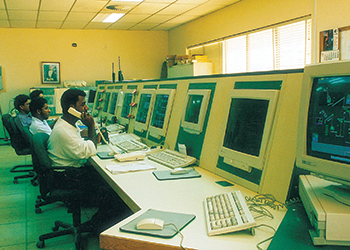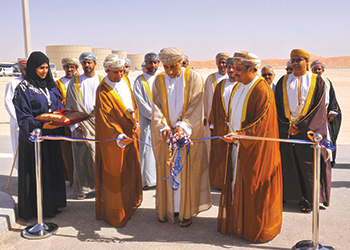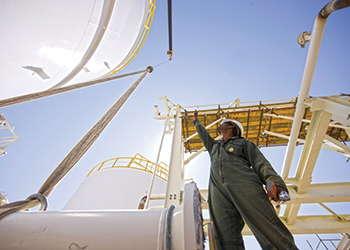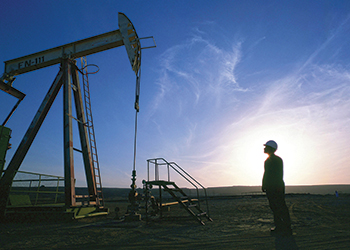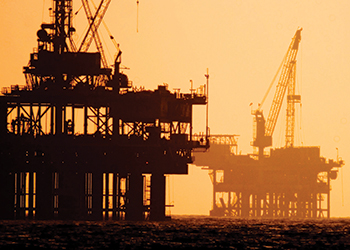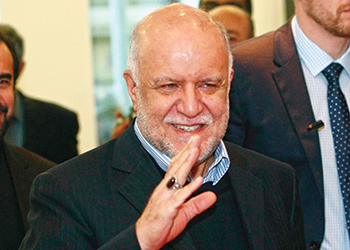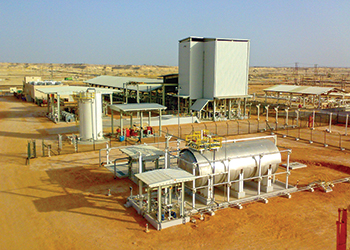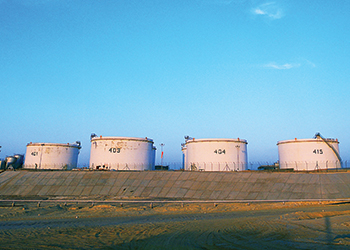
 PDO ... sweating assets
PDO ... sweating assets
Oman is pursuing its biggest energy project with the downstream Duqm complex that is due for completion in 2020 and which will include a 230,000 bpd refinery, a petrochemicals plant and a 200 million barrel oil storage terminal
Oman’s state-controlled and Shell-led oil and gas producer PDO had an average production of 570,534 barrels per day (bpd) last year, marking the firm’s highest level since 2006 and nearly a 4 per cent increase on the plateau target of 550,000 bpd. But PDO’s proactive cost-cutting strategies have not been immune from the impact of low oil prices.
PDO’s managing director Raoul Restucci says the company is investing $40 billion to hit its target of 600,000 bpd by 2019 and that the company must 'sweat our assets' for maximum value, adding that 'everything is staying the course and if anything, it is being accelerated.'
But small signs of economic stress have emerged. PDO has pulled back on the Habhab enhanced oil recovery (EOR) project and the Badour northeast project, with Oman’s oil minister Mohammed Al Rumhy saying that complex and expensive technology was the main stumbling block at Habhab. The ministry adds that this issue had triggered second before the decline in oil prices.
'Hopefully we will go back to it again when there is better technology, methodology and hopefully, a better oil price,' Al Rumhy says. Officials stress that the two projects represent a very small portion of a much wider project base.
Restucci says that some of the EOR projects that are completed have rates of return in excess of 100 per cent, with PDO still on track to have EOR projects account for 33 per cent of the firm’s total production by 2025. There are around 22 projects currently at various stages.
PDO accounts for 70 per cent of Oman’s oil production, which totalled 943,000 bpd of crude and condensates in 2014, coming in around the same level as 2013. Despite missing its target of 950,000 bpd last year, Muscat is aiming for 980,000 bpd this year.
The ministry spent $8.7 billion on the country’s oil sector and $2.8 billion on natural gas production last year. Oil reserves rose by 393 million barrel to 5.306 billion barrel last year, while 1.9 trillion cubic feet (tcf) of natural gas was added, lifting total natural gas reserves to 24.3 tcf.
Muscat’s plans to market oil blocks have taken a knock. French major Total has pulled out of deepwater Block 41, joining Norwegian firm DNO and Hungarian oil group MOL’s recent departure from Blocks 31 and 34, respectively. Limited commercial success triggered Total’s retreat, which the ministry admitted will make its job marketing the blocks 'in the next few years' more challenging. Total acquired the additional acreage in December 2013, which covered a large unexplored area of almost 24,000 sq km in water depths in a 30-3,000 m range.
Oman’s state-owned refiner Orpic saw a more challenging 2014, as low oil prices, squeezed margins, including those in the petrochemical aromatics markets, left the company $4 million short on its target of $725 million profit. Weakening oil prices since last June cost Orpic lost $571 million and technical issues at the 116,400 bpd Sohar refinery cut operations by 76 per cent and cost $111 million, squeezing the firm’s balance sheet further.
Chief executive Musab Al Mahruqi says the company is looking to borrow up to $3.7 billion to support its Liwa plastics project by year-end, which would mark the country’s largest internationally-supported project financing.
Despite strained margins, Muscat is still keen on stretching its downstream operations. Muscat is pursuing its biggest energy project with the downstream Duqm complex that is due for completion in 2020 and that will include a 230,000 bpd refinery, a petrochemicals plant and a 200 million barrel oil storage terminal. The expansion at the 116,400 bpd Sohar refinery to boost its output by 70 per cent is still due for completion in early 2017.
Progress on Oman and Iran’s plans to build an underwater natural gas pipeline between the two countries remain slow, with both sides yet to tie down a route for the 260 km project. The initial completion date of 2017 has been scrapped, but Oman’s oil and gas ministry remains confident that the project will be realised, with the latest export volume of 20 million cum/d (7.3 billion cum/yr) of gas agreed in September.
Meanwhile, Al Rumhy has spoken out against Opec’s policy and decision-making processes saying it is common practice for Opec and non-Opec oil producers to maintain an open dialogue.
 |
Al Rumhy ... expanding Oman’s hydrocarbon sector |
'That has not happened this time around,' he says, suggesting many non-Opec producers would have gladly joined an Opec round tabarrele to address oversupply. But 'some prefer to focus on increasing their market share instead of increasing price,' said Al Rumhy. The oil minister says he expects oil prices to be $55-$65/barrel for the rest of this year.
The ministry adds that it will be near impossible to sustain the country’s current budget 'over the coming years' if the oil prices remain around current levels, with the Brent crude price currently at $59/barrel. Oil production is the backbone of Oman’s economy and is projected to account for 79 per cent of total revenue of OR11.6 billion ($30.1 billion) this year, with Muscat’s 2015 budget based on an oil price of $75/barrel, down from $85/barrel last year. But this new level is still significantly higher than the oil prices this year.
Al Rumhy reiterates that Oman is moving ahead with the development plans despite the lower oil price environment. He says: 'We are not slowing down in any of the field developments... the only victim of the low oil price is one field ‘Habhab’ which requires a complex technology. The field itself is very complex. That is the only project that we have temporarily shelved. Really, it is not because of the (low) oil price. We did some tests using some chemicals to reduce the viscosity of the accumulation and the cost of the chemical is very high and it is a very difficult chemical to handle. So everything came back to the drawing table, we reviewed and studied it again.'
'Actually even before the collapse of the oil prices that was almost a decision. It is just a coincidence that the review of all our projects including Habhab was done after the collapse of the oil price and now we are telling everybody that this project is now officially shelved; we hope to come back again when there is a better technology, better methodology and hopefully, better price for that type of crude oil. But we have not slowed down in any project.'
Oman has planned for a total capital and operating budget of $11.5 billion in 2015. It includes $8.7 billion for the oil sector and $2.8 billion for the gas sector. The numbers were confirmed by Salim bin Nasser Al Aufi, Undersecretary, Ministry of Oil & Gas. He also says that Oman added 393 million barrels to the oil and condensate reserves in 2014. As a result, the sultanate’s total reserves stand at 5,306 million barrels.
In 2014, Oman’s oil and condensate production was 943,000 bpd. This year we are targeting 980,000 bpd for oil and condensate,' he states. The total oil production in 2014 was 344.5 million barrels. The average oil price realised in 2014 was $103 a barrel. The highest price point was $108 and the lowest was $87.
On the gas front, Aufi says that Oman added 1.9 tcf to the reserves last year, taking the total gas reserves to 24.3 tcf. The gas production in 2014 was 103 mmcmd and overall Oman produced 1.33 tcf gas in 2014.
Talking about the Omanisation in the operating companies, he says that 1,600 new Omanis joined the work force in 2014. A total of 12,000 Omanis are working in the operating companies and the average Omanisation rate is 79 per cent.
On the issue of reduction of the costs by the operators and the contractors, Dr Al Rumhy gave the example of how Petroleum Development Oman (PDO) is handling this as he said, PDO had (recently) engaged almost all contractors; over 150 contractors and service providers working with PDO, this is just an example. And the idea was both sides should sit together and find ways of optimisation. The results were extremely encouraging.'
Corroborating, Restucci adds: 'Historically, every time there is a price decline the natural reaction of the industry is the operators will send a firm letter to the service entities, to the contractors and say thou shall reduce the cost by x, (say) 20 per cent, 25 per cent. Very often that is in excess of the survival margin, it just destroys the industry because players don’t survive.
'A few years later, when there is a recovery in the prices, you no longer have the competition or sustainability of players. These short term wins actually turn into a real pain later. We have taken a very different approach. We have engaged with the contracting community and said look we have this challenge and how do we reduce cost that creates long term sustainability, win-win arrangements in this difficult period. We don’t want to destroy your margins but we have to become effective and cheaper... It’s all about working together.'
On the Iran-Oman gas project, Al Rumhy says: 'The discussion is going on, it has many facets. The first part is to agree on the route and we are working on that. Once we know the route we will move to the second phase which is the design of the pipeline itself.'
Meanwhile. Oman has set a 2015 oil production target of 980,000 bpd while maintaining 950,000 bpd as its forecast production plateau over the longer term, Al Rumhy says.
'We have started this year better than last year so we are going in that direction,' Al Rumhy says.
The ministry was seeking to achieve total oil and condensate output from Oman of at least 950,000 bpd each year for at least the next decade, with the hope that in some years production might be higher, he adds.
'The sultanate’s policy is to maintain 950,000 bpd. If we increase it, it would be good,' Rumhy says.
Much of Oman’s projected incremental output will be contributed by Petroleum Development Oman, a joint venture between Oman’s government (60 per cent) and international partners Shell (34 per cent), Total (4 per cent) and Partex (2 per cent).
PDO was rapidly closing in on a new medium-term production target of 600,000 bpd after averaging 570,000 bpd in 2014, some 20,000 bpd above its existing commitment to deliver 550,000 bpd over the next 10 years, says Restucci.
 |
Restucci ... focus on localisation |
That output level was the highest the company has achieved since 2006. As a taste of what was already possible under optimal conditions, the company Sunday pumped oil at an average rate of 595,000 bpd, Restucci says.
PDO says it was 'successfully' working towards a new sustainable long-term production plateau of 600,000 bpd by 2019.
Restucci says he thought the new target would be reached sooner, although PDO had not made a commitment to deliver annual production of more than 550,000 bpd in any year prior to 2019.
PDO was seizing on the current oil price downturn as an opportunity to work more closely with contractors on projects to increase operational efficiency and reduce waste, Restucci says. The company was not seeking to cut its total spending on oil and gas exploration and development but rather to ramp up production while lowering per barrel costs, he adds.
'PDO is a reliable supplier and we intend to get even better and more efficient at exploring and extracting the hydrocarbons which power Oman,' Restucci says.
He says PDO was budgeting about $6 billion in annual capital spending over the next several years. It was accelerating development of a number of recent conventional oil and gas discoveries while applying technology to limit decline rates from existing fields.
Despite Oman’s complex geological environment, which makes oil production in the sultanate more challenging and costly than in neighboring Middle East oil producing states, PDO’s production portfolio was profitable at current international oil prices and well below, Restucci adds.
Al Rumhy says almost all Omani oil and gas projects announced in the sultanate before the recent oil-price slide were still moving ahead. The only major exception was development of the Habhab heavy oil field, which would have required the application of complex solvent injection technology.
'The cost of the chemical is very high and it is difficult to handle. Going back to the drawing board was the decision even before the oil price fell. The project is now officially shelved, hopefully to come back when there is better technology,' the minister says.
PDO, meanwhile, had some 22 enhanced oil recover pilot tests in progress, and was expecting that some would work while others would fail.
'Many are very attractive. We are very confident that even if prices were to be low for some period, we would be able to deliver this production,' Restucci says.
Oman government is encouraging multinational oil giants to find new reservoirs in a move to sustain production levels.
As huge investment is required for bringing crude oil and natural gas above the ground in view of the peculiar nature of reservoirs in the Sultanate, the government has been encouraging multinational firms to undertake exploration on a production sharing basis. The government is trying to open up both offshore and onshore blocks for development in a bid to enhance hydrocarbon resources in the country.
Twenty-nine oil blocks have already been awarded to international firms for exploration and in recent years, the initiative is gaining prominence.
Some of these blocks started producing oil, while others are in various stages of studies and development. Now the ministry of oil and gas is in an advanced stage to award three oil blocks to international firms for exploration in Southern Oman, which is part of five blocks tendered last year.
Oman government early this year signed one each production sharing agreement with Total Exploration and Production Oman Petroleum B V and Petrogas Kahil for developing an offshore oil barrelock in northern coast and an onshore barrelock in Al Wusta region. The first agreement with Total was for developing offshore block 41 spread in a large 23,850 sq km area off northern coast, while pact with Petrogas was for onshore block 55, spread in an area of 7,564 sq km.










































































